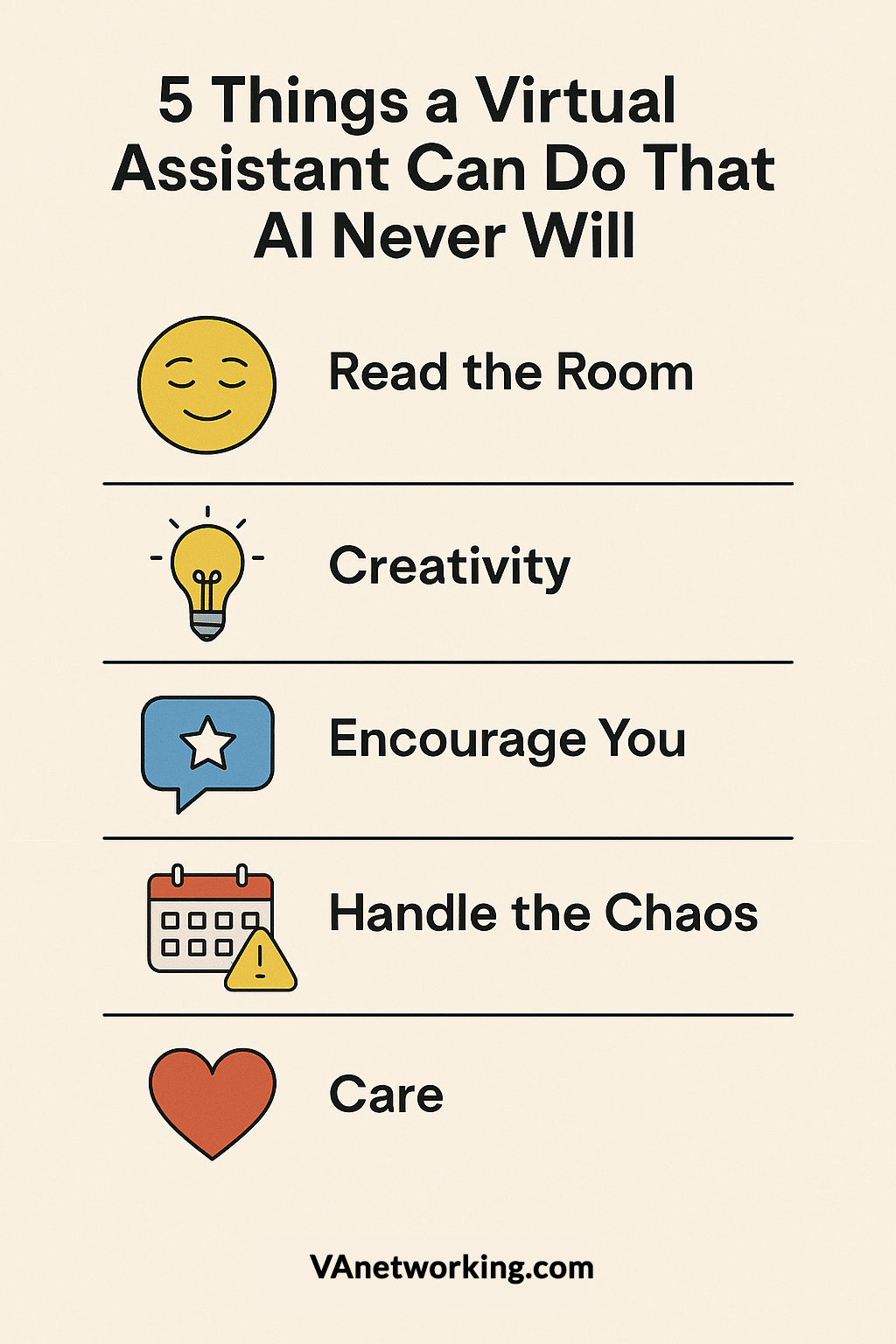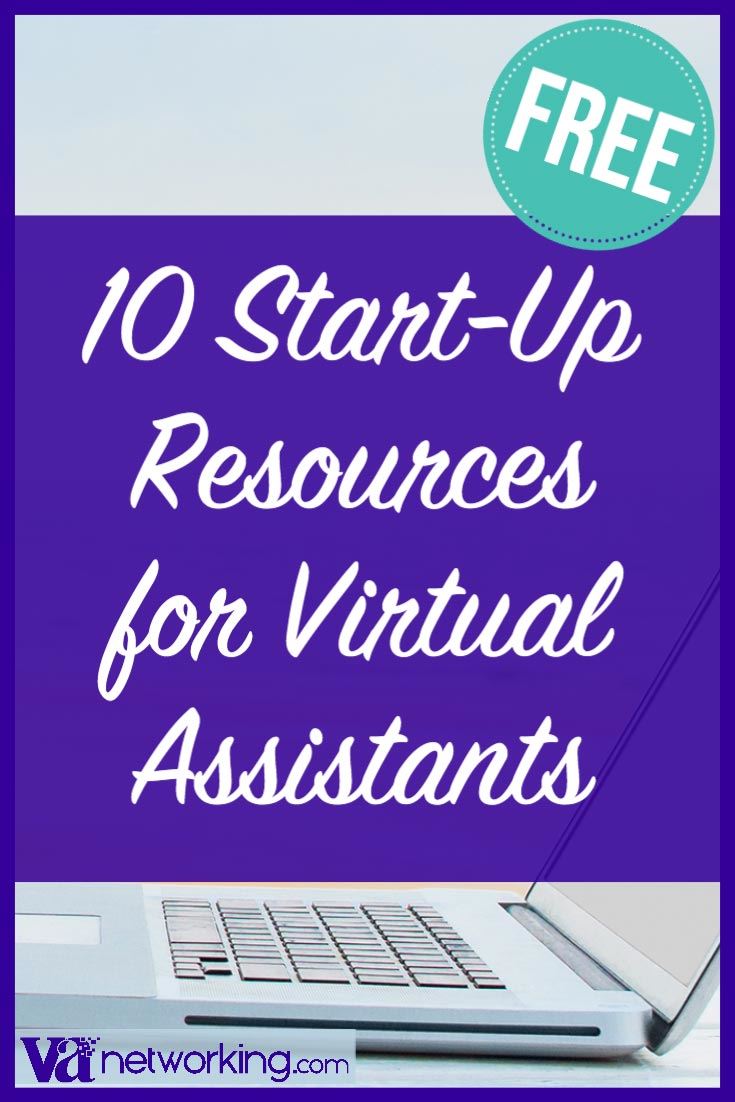What’s the Difference Between a Virtual Assistant and an AI Assistant?
The other day I told someone I’ve been helping Virtual Assistants grow their businesses since 2003. Their response?
“Oh, like Siri?”
I had to laugh out loud at that one — but it also made me realize something important.
Apparently, to the younger crowd, “Virtual Assistant (VA)” means an AI bot that sets your reminders, tells you the weather, and maybe plays your sad-girl playlist when you break up with Chad. (Thanks, Alexa.)
But here’s the thing: when I say Virtual Assistant, I mean a real human professional — not a robot in your pocket. And trust me, if you’ve ever hired a Virtual Assistant for your business, you know they’re about as far from Siri as you can get.
 This generational language gap is hilarious — and a little concerning. Let’s break it down:
This generational language gap is hilarious — and a little concerning. Let’s break it down:
- Boomers: “Oh, like an executive secretary but online?”
- Millennials: “My Virtual Assistant helps me manage my inbox, my social media, and my sanity.”
- Gen Z: “Cool, can your Virtual Assistant order me a burrito like Alexa?”
Somewhere between the early 2000s and today, the definition of Virtual Assistant shifted. And while AI assistants have their place, let’s set the record straight on what a Virtual Assistant really is.
A Short History of the Virtual Assistant Industry
The phrase Virtual Assistant didn’t appear out of thin air. It has roots going back over two decades:
- 1990s: As internet access improved, entrepreneurs started experimenting with hiring remote administrative support.
- Early 2000s: The term “Virtual Assistant” was coined to describe skilled professionals offering business services online. (This is when I launched the Virtual Assistant Networking Association in 2003 — we were trailblazers before Zoom was even a thing.)
- 2011–2014: Siri and Alexa burst onto the scene, and suddenly “Virtual Assistant” meant a chatty robot who sometimes misunderstands you.
- 2020s: AI exploded into mainstream use (hello, ChatGPT), and now the confusion is everywhere. Businesses Google ‘hire a Virtual Assistant’ and half the results are software bots instead of real people offering Virtual Assistant services.
But here’s the truth: the Virtual Assistant profession was built by humans, for humans. It’s a legitimate, global industry where freelancers provide valuable business support.
What Is a Virtual Assistant, Really?
Let’s get crystal clear.
A Virtual Assistant is:
✔️ A real human freelancer who runs their own business.
✔️ Someone who provides Virtual Assistant services like admin support, marketing, customer care, bookkeeping, tech troubleshooting, or project management.
✔️ A professional you can hire to lighten your workload, grow your business, and keep you sane.
A Virtual Assistant is NOT:
❌ Siri
❌ Alexa
❌ Google Assistant
❌ ChatGPT (sorry friend, but you’re not invoicing clients anytime soon)
Virtual Assistant Services: What They Can Actually Do
When you hire a Virtual Assistant, you’re hiring a professional who can handle tasks like:
- Managing your inbox and calendar.
- Creating content for your blog, newsletters, or social media.
- Handling customer service requests with actual empathy.
- Organizing projects and coordinating deadlines.
- Running marketing campaigns.
- Bookkeeping, invoicing, and tracking expenses.
In short, a Virtual Assistant keeps your business running smoothly while you focus on growth.
Compare that to asking Siri to book your flight: “Here’s what I found on the web.” Yeah, not the same.
Real Stories of Virtual Assistants in Action
Want proof? Let’s look at what human Virtual Assistants do in the real world:
- A business owner drowning in 2,000 unread emails hired a Virtual Assistant who set up systems, filtered the junk, and created templates. By the end of the week, the inbox was manageable and client satisfaction was up.
- A coach wanted to launch an online course but was overwhelmed with tech. Their Virtual Assistant set up the entire system — from landing pages to payment processors — and the launch doubled expected sales.
- A small e-commerce shop outsourced customer service to a Virtual Assistant who handled complaints with care. Result? Repeat buyers, glowing reviews, and a lot less stress for the owner.
- From coaches and consultants to e-commerce shops and busy entrepreneurs, businesses of all sizes hire Virtual Assistants to save time and grow smarter.
Notice the pattern? These are things no bot is going to do well — because they require judgment, personalization, and good old-fashioned human care.
5 Things a Virtual Assistant Can Do That AI Never Will
Let’s get cheeky. Here are five things you can expect from a human Virtual Assistant that no AI bot can deliver:
- Read the Room. A Virtual Assistant knows when NOT to send that pitch email because the client is at their mom’s funeral. A bot? Not so much.
- Creativity. AI can spit out words, but only a human Virtual Assistant can make them sound like you.
- Encourage You. Bots don’t cheer you on. Your Virtual Assistant will send you a GIF and a “you’ve got this!” on launch day.
- Handle the Chaos. Three time zones, ten personalities, one looming deadline. AI short-circuits. A Virtual Assistant thrives.
- Care. Real, human, heartfelt care. That’s something no code can replicate.

Funny Scenarios: Ask Siri vs Ask a Virtual Assistant
Let’s play a game:
- Ask Siri to reconcile your books.
Siri: “Sorry, I don’t understand the word QuickBooks.” - Ask Alexa to manage your client relationships.
Alexa: “Playing ‘Toxic’ by Britney Spears.” 🎶 - Ask a Virtual Assistant the same questions.
Virtual Assistant: “Done, organized, and the client just emailed to say thank you.”
See the difference?
Why the Confusion Matters
Here’s where this generational mix-up gets serious.
- For businesses: If you search “hire a Virtual Assistant” and land on AI bots instead of real professionals, you’re missing out on the support that can actually scale your business.
- For freelancers: If you’re building a career as a Virtual Assistant, you don’t want to be lumped in with free tech tools. Your expertise deserves recognition and fair pay.
This is why defining and protecting the Virtual Assistant profession is so important.
The Future of Virtual Assistants in the Age of AI
Now here’s the twist: Virtual Assistants aren’t ignoring AI. They’re using it.
In fact, we even teach it inside our AIVAmastery.com course — showing Virtual Assistants how to integrate AI into their businesses so they can save time, serve clients better, and stay ahead of the curve in the Virtual Assistant industry. 💜
The most successful Virtual Assistants today leverage AI to make their services more efficient, creative, and scalable:
- AI drafts → the VA polishes.
- AI analyzes → the VA interprets.
- AI reminds → the VA implements.
Instead of replacing Virtual Assistants, AI is becoming a powerful tool in their toolkit
Businesses win because they get the best of both worlds: cutting-edge tech combined with the human touch.
Virtual Assistants Aren’t Robots — They’re Better
So, let’s clear it up once and for all:
A Virtual Assistant (VA) is not Siri. Not Alexa. Not ChatGPT. A Virtual Assistant is a real human freelancer who runs their own business and supports clients with administrative, technical, and creative services — think calendars and emails, websites and tech, blogs and graphics.
Virtual Assistants aren’t going anywhere. In fact, they’re the ones helping businesses use AI smarter while still providing the empathy, creativity, and strategy no robot can replicate.
So next time someone says, “Oh, you’re like Siri?” smile and say:
“Nope. Better. I’m a Virtual Assistant — a real human helping real businesses thrive.”
💜 And if you want to join the longest-running Virtual Assistant community online (since 2003, thank you very much), come hang out with us at VAnetworking.com.
💜 And if you’re ready to level up your skills with AI, check out our AIVAmastery.com training program built specifically for Virtual Assistants.







